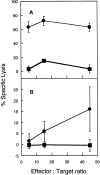Induction of an antigen-specific, CD1-restricted cytotoxic T lymphocyte response In vivo
- PMID: 9449723
- PMCID: PMC2212129
- DOI: 10.1084/jem.187.3.433
Induction of an antigen-specific, CD1-restricted cytotoxic T lymphocyte response In vivo
Abstract
The majority of T cell responses are restricted to peptide antigens bound by polymorphic major histocompatibility complex (MHC) molecules. However, peptide antigens can be presented to T cells by murine non-MHC-encoded CD1d (mCD1) molecules, and human T cell lines specific for nonpeptide antigens presented on CD1 isoforms have been identified. It is shown here that antigen-specific, mCD1-restricted lymphocytes can be generated in vivo by immunizing mice with a combination of plasmids encoding chicken ovalbumin, murine CD1d, and costimulatory molecules. Splenocytes from immunized mice have CD1d-restricted, MHC- unrestricted, ovalbumin-specific cytolytic activity that can be inhibited by anti-CD1 antibodies as well as a competing CD1-binding peptide. These results suggest a physiologic role for murine CD1d to present exogenous protein antigens.
Figures




Similar articles
-
Presentation of peptide antigens by mouse CD1 requires endosomal localization and protein antigen processing.Proc Natl Acad Sci U S A. 1998 Nov 24;95(24):14314-9. doi: 10.1073/pnas.95.24.14314. Proc Natl Acad Sci U S A. 1998. PMID: 9826697 Free PMC article.
-
Peptide binding and presentation by mouse CD1.Science. 1995 Jul 14;269(5221):223-6. doi: 10.1126/science.7542403. Science. 1995. PMID: 7542403
-
Antigen-presenting function of the mouse CD1 molecule.Ann N Y Acad Sci. 1996 Feb 13;778:288-96. doi: 10.1111/j.1749-6632.1996.tb21136.x. Ann N Y Acad Sci. 1996. PMID: 8610982 Review.
-
CD1 antigen presentation and infectious disease.Contrib Microbiol. 2003;10:164-82. doi: 10.1159/000068136. Contrib Microbiol. 2003. PMID: 12530326 Review.
-
The natural immune response to inhaled soluble protein antigens involves major histocompatibility complex (MHC) class I-restricted CD8+ T cell-mediated but MHC class II-restricted CD4+ T cell-dependent immune deviation resulting in selective suppression of immunoglobulin E production.J Exp Med. 1993 Sep 1;178(3):889-99. doi: 10.1084/jem.178.3.889. J Exp Med. 1993. PMID: 8102390 Free PMC article.
Cited by
-
Stromal cell independent B cell development in vitro: generation and recovery of autoreactive clones.J Immunol Methods. 2010 Mar 31;354(1-2):53-67. doi: 10.1016/j.jim.2010.01.007. Epub 2010 Jan 28. J Immunol Methods. 2010. PMID: 20109461 Free PMC article.
-
Structure of an α-Helical Peptide and Lipopeptide Bound to the Nonclassical Major Histocompatibility Complex (MHC) Class I Molecule CD1d.J Biol Chem. 2016 May 13;291(20):10677-83. doi: 10.1074/jbc.M115.702118. Epub 2016 Mar 22. J Biol Chem. 2016. PMID: 27006394 Free PMC article.
-
Presentation of peptide antigens by mouse CD1 requires endosomal localization and protein antigen processing.Proc Natl Acad Sci U S A. 1998 Nov 24;95(24):14314-9. doi: 10.1073/pnas.95.24.14314. Proc Natl Acad Sci U S A. 1998. PMID: 9826697 Free PMC article.
-
The murine nonclassical class I major histocompatibility complex-like CD1.1 molecule protects target cells from lymphokine-activated killer cell cytolysis.J Exp Med. 1999 Feb 1;189(3):483-91. doi: 10.1084/jem.189.3.483. J Exp Med. 1999. PMID: 9927510 Free PMC article.
-
Binding and antigen presentation of ceramide-containing glycolipids by soluble mouse and human CD1d molecules.J Exp Med. 1999 Oct 18;190(8):1069-80. doi: 10.1084/jem.190.8.1069. J Exp Med. 1999. PMID: 10523605 Free PMC article.
References
-
- Porcelli SA. The CD1 family: a third lineage of antigen-presenting molecules. Adv Immunol. 1995;59:1–98. - PubMed
-
- Castano AR, Tangri S, Miller JE, Holcombe HR, Jackson MR, Huse WD, Kronenberg M, Peterson PA. Peptide binding and presentation by mouse CD1. Science. 1995;269:223–226. - PubMed
-
- Calabi F, Belt KT, Yu CY, Bradbury A, Mandy WJ, Milstein C. The rabbit CD1 and the evolutionary conservation of the CD1 gene family. Immunogenetics. 1989;30:370–377. - PubMed
-
- Calabi F, Jarvis JM, Martin L, Milstein C. Two classes of CD1 genes. Eur J Immunol. 1989;19:285–292. - PubMed
Publication types
MeSH terms
Substances
Grants and funding
LinkOut - more resources
Full Text Sources
Other Literature Sources
Research Materials

